This page will provide a first hand look at the
Orion SpaceProbe 3 Altazimuth Reflector Telescope. The SpaceProbe 3 Alt-Az telescope is an entry level Newtonian reflector type telescope on an Alt-Azimuth mount. If you want the quick summary of this page, the SpaceProbe 3 Alt-Az is a great entry level telescope if your budget allows only around $120. It will give you an honest and true start in astronomy at about the lowest cost possible.
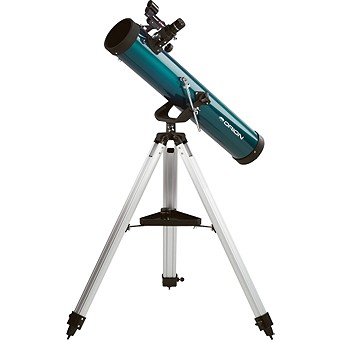
The Orion SpaceProbe 3 Altaz Reflector Telescope.
This is a good choice for a first telescope for a young person just starting out. This telescope is for astronomy; you can look at terrestrial targets however they will appear upside down (normal for Newtonian Reflector telescopes) and many viewers will find this annoying. This telescope is a good choice for people with limited budgets, or for those who don't want to risk spending a lot of money only to later find out that astronomy was only a passing interest for their child.
This telescope was very well packed for shipping. It arrived with the package showing the normal dents and scuffs that a box receives during a cross country trip in the back of a FedEx truck. The telescope was double boxed in heavy cardboard and the internal components were further packed in additional boxes and/or bubble wrap. All components were present and nothing was damaged. The way this scope was packed, it would have taken some serious abuse to damage the contents within (abuse that would be well beyond even rough handling).
Keeping in mind that this is a $100 telescope, the construction quality is very good. A number of components are made of plastic (no way around this in a scope of this price range). Plastic components include the focuser assembly, some of the brackets on the tripod, knobs and other minor components. The optical tube is rolled aluminum (it is very round unlike some scopes I have seen that use this construction method) and it is very nicely finished. The mount legs are aluminum and the mount itself is cast aluminum. Overall the telescope has a nice feel and it looks great.
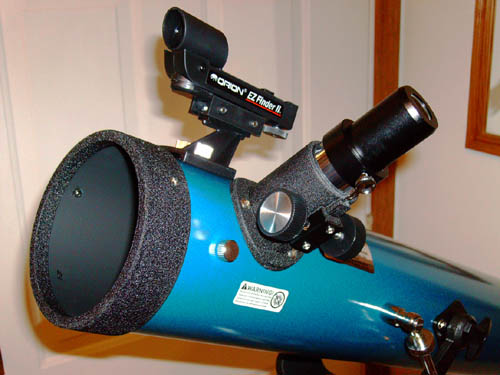
Another view of the Orion SpaceProbe 3 Altaz Reflector Telescope (Click the image to see a larger image).
The primary mirror of this telescope is a spherical mirror. Experts will comment that a parabolic mirror is the "only way to go" for a telescope, however for longer focal length mirrors (such as that used in the SpaceProbe 3) a spherical figure will perform in an almost indistinguishable manner as compared to a parabolic one (when I have time I will do the math to prove this out for those readers interested in the technical details). Regardless of theory, my tests in the field with this scope show it to be a remarkable performer (more on that below). Any experienced astronomer will tell you that the two most important things with any telescope are quality of the optics and stability of the mount. The eyepieces that come with this telescope are smartly chosen by Orion. Included is a 25mm Explorer II eyepiece and also a 10mm Explorer II eyepiece, providing magnifications of 28x and 70x. These magnifications are perfectly suited to this instrument. The 25mm eyepiece provides a nice wide field of view (making it ideal for objects like the Beehive cluster, the Pleiades and the Orion Nebula). The 10mm eyepiece provides enough power to see tremendous detail on the Moon and enough power to see the major planets and their basic features.
Orion's telescope manuals are very well written. They are obviously written (and/or reviewed) by someone who has a good working knowledge of astronomy and telescopes. The instructions are written in a clear and concise manner and include a number of photographic illustrations. Included are sections on how to do an alignment of the optics (called collimation), these are well written. Overall the manual has a very clean and professional look. Some entry level telescopes come with manuals that are poor... they are basically translations of manuals originally written in another language (usually Chinese) and they are typically full of grammar and spelling errors. Orion's manuals are far superior to such manuals. If I were writing Orion manuals myself there is little if anything I would change.
My first views of the night sky using this telescope exceeded my expectations. The optics are remarkably good for a scope in this price class! Stars focused to nice tight points (as they should) and the overall image quality across the field of view was very sharp. The Red Dot finder worked well in aiming the scope (once you perform the initial alignment). I looked at the following objects on my first night out: The Orion nebula (M42), the Crab Nebula (M1), the Pleiades (M45), Auriga clusters M37, M36 and M38, the Beehive cluster (M44) and also M78 in Orion. Many of the aforementioned objects are showpiece objects and the SpaceProbe 3 showed them very nicely. A few nights later the waxing crescent Moon came into visibility and the views of it were very sharp and clear. Venus was also visible, its nearly half phase was plainly visible.
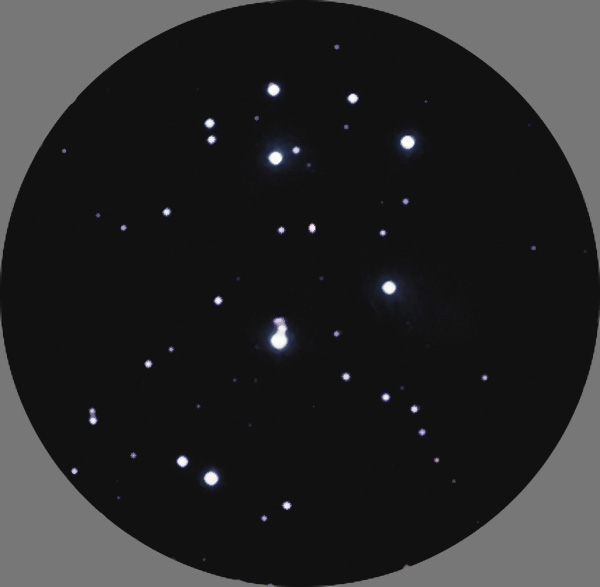
This photo shows very approximately what you'll see when looking at the Pleiades using the 25mm (28x) low power eyepiece. This photo is pretty accurate with regard to the field of view that you'll get using the 28x eyepiece. Note however that the stars will look quite a bit different than the image shown here. In the telescope the bright stars will be bright pinpoints of light (not white blobs like photos show). Also you probably won't see as many faint stars as most images show.
I found the SpaceProbe 3's mount to be adequately stable and easy to use. I extended the tripod legs to their maximum height (I am over 6' tall). The optical tube was easy to aim and stayed put when I let go of it (I had light tension on the altitude and azimuth locking knobs). Using the Red Dot finder and the 25mm eyepiece allowed me to consistently place objects into the field of view (you do have to know where objects are in the sky of course). Overall I found the SpaceProbe 3 Alt-Az telescope a very pleasing instrument to use.
I did find one minor issue with the SpaceProbe 3. The threaded studs that are used to attach the Red Dot finder are smaller than the mounting holes that are provided on the finder. Thus, when you try to secure the finder using the provided knobs it can move around a bit (once it is tight this is not an issue). To keep the finder from potentially moving around a bit of hot glue or contact cement could be used to really secure the finder (in addition to the knobs). The Red Dot finder has provisions for adjusting alignment, so there is no worry about the exact position of the bracket on the optical tube (so long is it is placed over the threaded studs).
Under the stars I did notice that due to the design of the mount there is an area of sky directly overhead that cannot be viewed (this is because when you point the optical tube high up the back end of the tube will hit the tripod and not allow aiming the scope directly up). This is not a major issue. To allow viewing directly over head I reduced the height of one of the tripod legs by a few inches and then I was able to access the sky directly overhead. This is not a major issue, the amount of sky that cannot be viewed (without the adjustment I mention) is not very big.
The only other comment I have is with regard to the tripod. When the tripod is set up it is quite stable for its class, however even with the legs fully retracted it is wide enough to be a little awkward in getting it out the back door of the house. This is not a major issue, just something to be aware of (if you purchase this scope for a child they might need a little help getting it out the door).
This is an entry level scope on a basic Alt-Azimuth mount; it is designed for viewing astronomical objects. That said, with the proper equipment and some trial and error (and luck), you could use it to take some basic photos of the Moon. You'd need a digital camera; most would work, while some would be a lot more preferable over others (in any case make sure to turn off the flash on the camera). To take a photo of the Moon, you would first get the Moon into the telescope's field of view (using the 25mm eyepiece). Then, you'd need to aim your digital camera's lens into the eyepiece opening (try not to actually touch the camera lens to the eyepiece as this will cause vibration and possibly could scratch either the camera lens or eyepiece). With the Moon in the telescope's field of view, you would then need to adjust the focus on the telescope (and possibly also the camera itself) until the image of the Moon is sharp and clear. You may also have to zoom the digital camera's lens to get a decent framing of the Moon (you may only be able to get a portion of the Moon into your camera's field of view). While all this is going on the Earth is of course rotating, so you'll have to stop and make adjustments to the telescope to get the Moon back into the center of the field of view. Take a number of images of the Moon using the camera's auto setting. If the images seem overexposed, you can also try a manual setting on your camera (to reduce the exposure times).
Below is a photo of the Moon that I took using the SpaceProbe 3 Alt-Az telescope (click on the image below to see the full resolution image). PLEASE NOTE: do not expect to be able to take a photo of this clarity on your first attempt! To get this photo I mounted the SpaceProbe 3's optical tube on an expensive tracking mount (Losmandy G-11); this allowed me to precisely center the Moon and not have it drifting out of the field of view while I was working on the image. I also used a specialized camera (the Orion StarShoot Solar System Color Imaging Camera II) to take this photo.
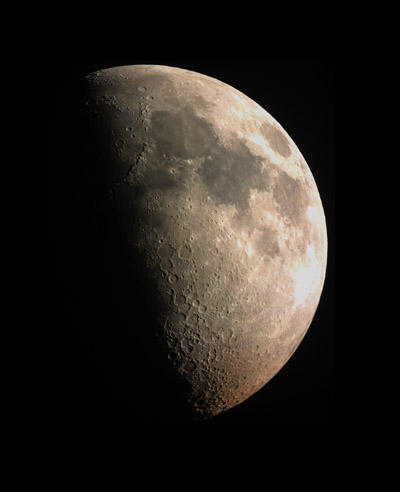
Photo of the Moon using the SpaceProbe 3 Optical Tube Assembly (Click the Photo to see the full size image)!
The main reason I am showing this photo is to give an idea of the optical quality of the SpaceProbe 3 Alt-Az telescope. I will be straight up honest: if you are just starting out in astronomy you'll likely not be able to get a photo like this without significant trial and error. On the upside, the image above (the large full size one you'll get when you click on the small image) gives an idea of the amount of detail you'll actually be able to visually see on the Moon using this telescope!
I own a number of telescopes, the
Orion SpaceProbe 3 Altazimuth Reflector Telescope is among the smallest and most basic of them. The performance of this scope exceeded what I expected, it has very good optics and the views are crisp and sharp. It is lightweight and easy to use. It will give you excellent views of the Moon and nice images of many of the brighter objects in the sky. The scope comes with two well matched eyepieces that will allow you to easily locate objects and to also see closer views of the Moon and planets. This telescope costs around $100 (closer to $115 with shipping); I find it to be an honest and true performer that represents a great value. You may be able to find a less expensive scope of the same size, however it is likely to come with useless accessories that would ultimately result in a disappointing experience. If your budget only allows around $100 for a telescope, this would be a nice choice.
Full details of scope are here at Orion's web site:
Orion SpaceProbe 3 Altazimuth Reflector Telescope
Below are some additional photos of the scope. Click on the small images and a large format image will open in a new window.
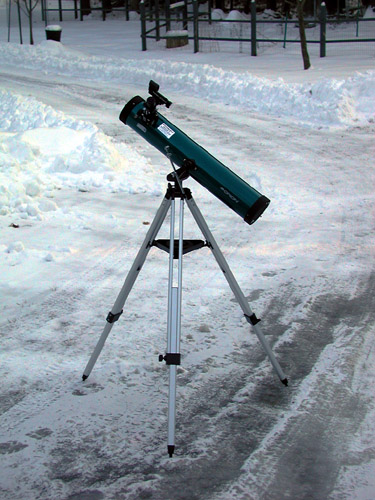
The Orion SpaceProbe 3 Altaz Reflector Telescope sitting in a cold and snowy driveway!.
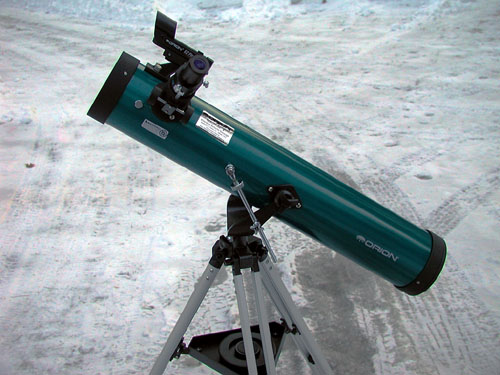
A slightly closer view.
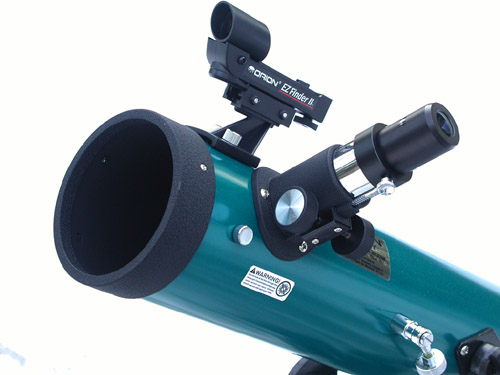
A close up of the front end of the scope.
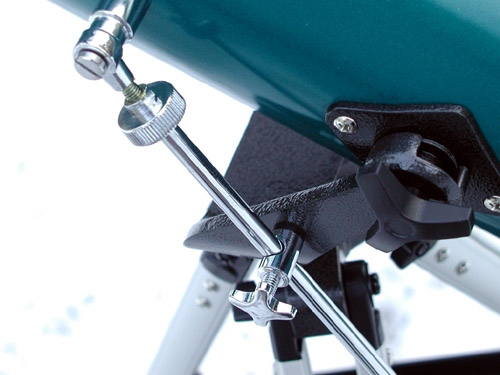
A close up of the Alt-Az mount.
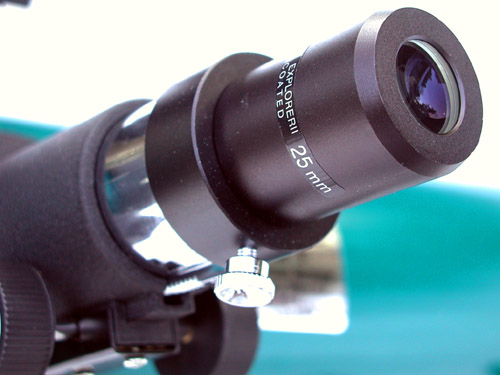
The Explorer II 25mm eyepiece (1.25" diameter) and the focuser. The bluish tint on the eyepiece glass is evidence of anti-reflection optical coatings (standard on any decent astronomical gear).
Use your browser's "back" button, or use links below if you arrived here via some other path:
This page is part of the site Amateur Astronomer's Notebook.
E-mail to Joe
Roberts
Images © Copyright Orion Telescope and Binocular and Joe Roberts; HTML text © Copyright 2008 by Joe Roberts.